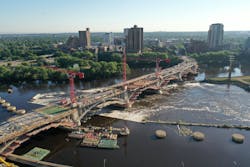Opened in 1918, the Third Avenue Bridge spans the Mississippi River in downtown Minneapolis and is listed on the National Registry of Historic Places.
It has an overall structure length of 1,888 feet and an out-out width of approximately 82 feet. It has seven reinforced-concrete arch spans, including five open-spandrel, rib-arch spans of 211 feet each, and two open-spandrel, barrel-arch spans of 131 feet each. There are two steel beam approach spans on the south, and two prestressed beam approach spans on the north.
Character defining features include the Melan system, the use of a reverse S-curve alignment to avoid unstable areas of the underlying limestone, the Classical Revival aesthetic features of the overlook piers and the 1939 ornamental railing which still exists on the bridge today.
HNTB led the project team in inspection, evaluation, scoping and design of the major bridge rehabilitation. To assess the bridge condition and work required to rehabilitate the bridge, Wiss, Janney, Elstner Assoc. (WJE) completed an in-depth, hands-on inspection and testing program and developed the Third Avenue Bridge Inspection and Condition Evaluation Report.
Concrete spalling and deterioration due to chloride exposure was prevalent across the bridge. Locked expansion joints were found to restrain thermal movement of the bridge, causing cracking in the under-reinforced spandrel columns, the large river piers, and spalling in spandrel cap beams.
John Schmitz, project manager at Ames Construction, said that rebar was visible in many areas.
“The joining point between the arches and columns were cracked in many locations with rebar deterioration resulting in section loss,” he said. “The arch structures themselves also have suffered from over 100 years of weathering, resulting in approximately 90,000sf of surface repair quantities anticipated.”
Rehabilitation of the Third Avenue Bridge, initiated to address the structure’s deteriorated conditions and extend its service life, required that the updated structure comply with Section 106 of the National Historic Preservation Act of 1966.
“The historic features identified for preservation (mainly pilasters, rail & board form finish) really make the bridge stand out from modern styles of bridges,” Schmitz said. “It reminds me of a time when architectural aesthetics were a high priority, the bridge is surrounded by building as old, or older than the bridge itself. From red brick buildings to granite & marble faced behemoths, it would look out of place with simple lines. Preserving these aesthetics helps us all to remember where we have come from and the means and methods of construction from the past.”
A 50-Year Design Life Rehabilitation plan was chosen. It proposed replacement of the deck, spandrels and major repairs to the piers and arches.
A leading cause of the bridge’s deterioration was the large number of expansion joints, which allowed chloride-laden drainage to reach the lower concrete elements. To address existing damaged concrete and reduce sources of future deterioration, the project team replaced the deck, cap beams and spandrel columns and rearticulated the bridge by reducing the number of expansion joints from 42 to 16.
The Third Avenue Bridge provides a critical river crossing for vehicles, buses, bicycles and pedestrians. Although the bridge would need to be fully closed to the public for the reconstruction of the deck and spandrels, the project team wanted to minimize impacts to traffic.
Through extensive coordination with local agencies and stakeholders, the design team developed a maintenance of traffic plan that allowed early contractor mobilization on one half of the bridge, while maintaining vehicular, bus, bicycle pedestrian traffic into and out of downtown Minneapolis, shortening the full-closure period by six months.
The project to rehabilitate the Third Avenue Bridge has entered its final stages and should be complete in August. Once finished, motorists will enjoy a smoother road surface, improved safety and accessibility features, and enhanced historic and visual features. R&B
Project: Third Avenue Bridge Rehabilitation
Location: Minneapolis, Minnesota
Owners: Minnesota Department of Transportation
Designer: HNTB Corporation led the team of: Wiss, Janney, Elstner Assoc. (WJE) Olson & Nesvold Engineers (ONE) Multivista, Dan Brown Associates Survey Solutions, Inc.
Contractor: Ames Construction, Inc. with Finely Engineering Group
Cost: $130 million
Length: 2,134 feet
Completion Date: Summer, 2023



